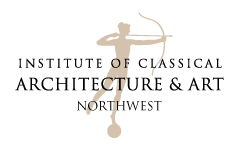Winterim Professional Intensive 2015
/Stacy Becker blogs about her recent experience in New York - participating in the ICAA's Winterim Intensive - as one of our region's talented up-and-coming Interior Designers.
The walk to the first day of class was a history lesson itself as I turned down West 44th Street in Midtown Manhattan. Classical architecture surrounded me, Doric columns and stacked stone flanking both sides of the street, along with brass door details, and rich carvings in the Ecole des Beaux-Arts style. The history of Manhattan lies in these historic yet beautiful buildings, and I welcomed the introduction to the neighborhood.
Grand Central Station Tour
Class started by finding a desk complete with lamp, t-square, and drafting table in a snug traditionally outfitted room lined with library books, plaster details and scaled models of classical buildings. The room was also filled with a great mix of students ranging from college age to seasoned professional architects, some of whom traveled from as far as New Zealand, while others just a few blocks away in Manhattan...or, for that matter, from across the country like myself, from the West Coast, and many places in-between.
Michael Teaching
Off to an introductory start, we began working with our instructors to become familiar with works of literature in support of the contemporary use of Classical Architecture today. American Vignola became the book we would resource endlessly for the following week, guiding our design decisions and informing style, proportion, and appropriate applications of both. We became familiar with classical moldings and were expected to draw examples by hand; the level of artistic talent from my peers was evident immediately. They were incredible. And, while I felt slightly intimidated, I also felt catapulted into excitement for my exposure to the instructors and the professionals that surrounded me. The following day ventured into a rich discussion around the theory and practice of proportion. I was mesmerized and felt a connection towards the reasoning for which classical principles and structures were created. What I did not realize, prior to this class, was the relationship between the science, theology, and architecture in Greek and Roman civilizations. It was a completely enriching conversation and I felt enlightened by the instruction and concepts.
Tuscan Column
The following few days were filled with drawing work, learning and recreating the classical orders; Tuscan, Doric, Ionic and Corinthian. This process was much less about numbers than I anticipated, though it was precise in terms of geometry and the subsequent breakdown of measure. It felt so good to understand the reason and principles behind these classical elements and to become part of a practicing group that was aware of this rich tradition. Many of the hours and days that followed focused on additional classical instruction and skill such as observational drawing and watercolor rendering, and the notion of applying such faculties to our surroundings and ongoing projects as professionals. How great to make the time to draw and paint, it had been far too long since I've done so, probably since college.
Watercolor Critique
Finally, the last days of the Winterim were spent creating and elaborating on a small design problem presented to each of us as individual assignments. The goal: to design a park entrance gateway that sat at the end of Main Street in a small New England town. Overall footprint preferences, door and window requirements, and architectural elements were outlined - as well as pediments at the front entrance - among others. The initial process was to block out architectural spaces and to begin an esquisse. The purpose of esquisse sketches are to create numerous quick ideas allowing critique, and respectively to outline the best design option. The following final days of class were utilized to refine the most promising esquisse and create a final presentation layout complete with floorplan, front elevation, side elevation, and section. Overall, I was thrilled by this process and very grateful for all of the feedback and criticism from our instructors. The final drawing and presentation was certainly the most intense and creative aspect of the Winterim course, an exceptional culmination of everything learned throughout the week. The experience will not be forgotten by myself or my classmates for quite some time. I still think back to the class on a daily basis and consider the lessons learned to have firmly cemented my passion for classical architecture.





